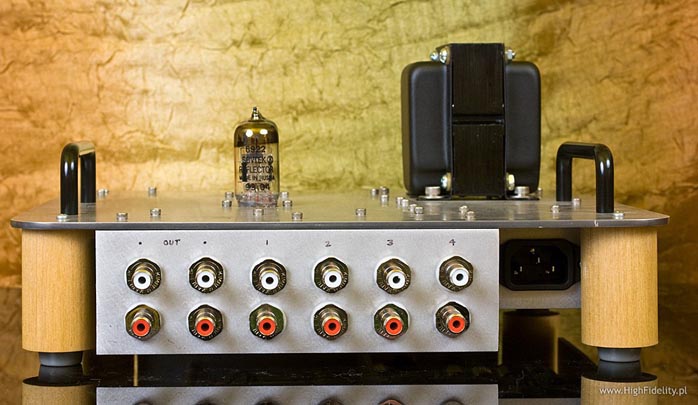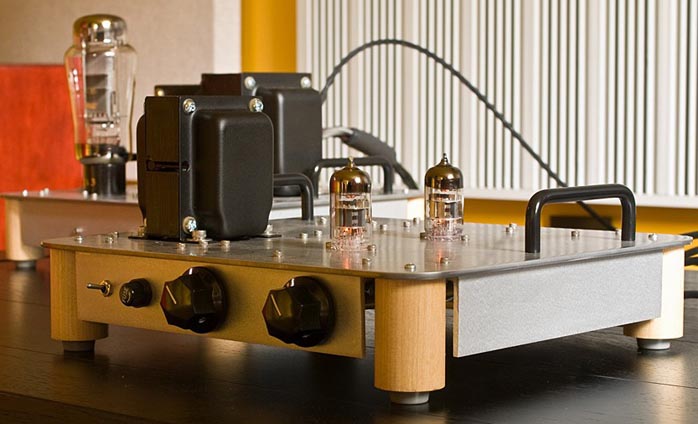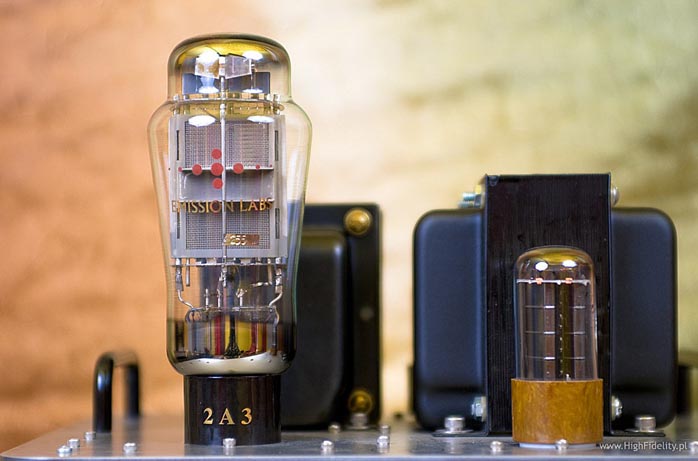This review page is supported in part by the sponsors whose ad banners are displayed below |
 |
 |
Next up was one of the latest Japanese issues of Pink Floyd’s Wish you were here. This edition’s phenomenal success can be easily verified by checking for prices reached in Internet auctions. For sure a few vinyl editions will exceed it but when looking at the CD medium, this is amongst the best of recordings. Although the first thing to mind was "despite the power of only 3 watts…", I should stop reminding you about the output power. I will simply agree with Avantgarde Acoustic’s engineer Matthias who, during the last Audio Show in Poland, opined that with a certain efficiency of loudspeakers, it does not matter if they are driven by a 1-watt or kilowatt amplifier (he also claimed equality for tube and transistor amplifiers but here I tend to disagree) but that what matters is the quality of the first watt.

My own hornspeakers are a modified Jerycho project with an efficiency of around 100dB so the first watt really s hould be enough to achieve all there is to be achieved from them. And if in fact more than the first watt which the Fi offers were used, the effect was fantastic with these discs including the Pink Floyd which is a solid Rock number played with verve, laden with harsh Gilmour guitar sounds, heaviness when Water’s bass lines dominate, fierce attacks from Mason’s drums and percussion and an incredible palpable sax from Dick Parry in "Shine on you crazy diamond ". In my opinion, the mastering of this disc achieves something I thought impossible - we can sit down and be 100% relaxed or flow with the music and live through all its emotions. The amplifier plays a big part in how we can follow along in a relaxed mood, or, when the volume scales, turn things into a volcano that spews with red-hot emotions.
|
|
|
Midnight Blue’s Inner City Blues is a disc to evaluate rhythm & pace with but also explore how an amplifier handles the human voice. And the Fi did handle them as only a brilliant tube amp can. Serena McDay and Artie Sherman singing the classic "Ain't no sunshine" created an unforgettable musical show, with Fi capturing the coarse textures of "black" voices in a very authentic way. The accompanying instruments were splendidly placed on a wide stage. I could see Selena sitting on a high stool in the front, with Artie at the Hammond next to here and behind them the rest of the band. This was recorded in the Mapleshade Records studios yet sounds like a classic small American Jazz club. A big kudos to Fi for reproducing brilliantly what’s on the disc but also that which could not be recorded – the thick juicy atmosphere we usually associate with Jazz clubs for which I envy the Americans…

By now I needed to check how these little amps would deal with rather more complex fare. I began with my favorite performance of Beethoven’s 9th Symphony with the Wiener Philharmoniker under Karl Böhm, quite a challenge for many amplifiers. The big orchestra, solo vocalists, choir and large dynamic fluctuations mean the amplifier must stretch its legs to control the speakers and prevent on-stage chaos. In my system each amplifier needed to control only one driver which on one hand simplified the task, on the other involves the challenges of a smaller diaphragm covering the entire bandwidth which is a job not many amplifiers have been fully equal to thus far.

Until now, I had a simple rule of thumb – the more power the better. A 20wpc KR Audio or 30wpc Ayon fared better with such music than my 10-watter. The Fi 2A3 was no exception, meaning those amplifiers handled it better. This however did not mean the Fi fared not. Minor confusion only set in at higher volumes. At reasonable levels, it did just fine. Neither orchestral soundstaging nor dynamics were problematic. Vocals were reproduced with high precision, splendid timbre and clear articulation. This was more than expected even from much more powerful and expensive amplifiers.
|
|
|
Finally my Gyro SE’s platter was graced with Metallica’s Black Album, the recently issued quad edition. I am not a big fan of such music but this recording is a classic beloved by many, even those who do not listen to metal on a daily basis. Being issued on four 45rpm discs was no mere marketing quirk to sell additional tens of thousands. This remaster really meant a new quality especially in dynamics. For my system it’s a truly difficult disc to play though it handles it well enough to enjoy "The Unforgiven" and "Enter Sandman" with real pleasure. The Fi gently softened the bass which actually became the only flaw I could detect. There was perfect order on the wide and deep stage which differentiates this edition from the digital variants where chaos rules on stage and sounds blend to make listening hard work. With this vinyl there was very good instrumental separation, cymbals were vivid, bass drums heavy—to the extent my system manages—and guitars splendidly grungy .

Of course a system like mine won’t reproduce full-scale sound with dense recordings regardless of what amplifier powers the speakers. This can annoy folks who are used to 15" woofers and a minimum of four drivers per side. Nevertheless, the monoblocks and preamplifier from Fi created the magic of tubes for this system in the best possible meaning of that term. Holography and spaciousness were of the highest level, timbral distinction of especially acoustic instruments and vocals hard to beat. Better valves add air and space which adds up to more realism, making this one of the premium reasonably-priced amplifiers to listen to music with.
Listen to music with? Theoretically all amplifiers are meant to but not all do it equally well. Some of them analyze the recordings for the smallest of details served up on a silver platter. Others appeal only to very specific tastes by underlining one or the part of the sonic spectrum. The 2A3 monoblocks from Don Garber will appeal to everybody. For some they could be the end of the audiophile road, for others simply nice amplifiers for pleasant music playback. In addition there are the other aspects described so well by Don’s earlier old ad. Fi glows nicely in the dark. Timbres can be shaped freely by rolling tubes. When something fails, any person with a soldering iron can replace a faulty part without grief in obtaining it. And the sound - well, I just told you about that. To me it is clear that Don Garber earned his esteem as American tube legend in full. I also very much appreciate his approach to business which makes his very best still reasonably priced. I also have to mention again the Soundclub company. Not many distributors will make the gesture of purchasing interesting but hard-to-obtain gear not just for strictly commercial but also educational purposes. That’s really something. People eager to learn about Fi needn’t buy on blind faith, pester some happy US owner or visit Don in New York. They can visit our shop in Warsaw.
|
Because I had also Tungsol 45 power triodes at my disposal, I tried them despite not being a perfect plug-in replacement for the 2A3s in this amp. This was my first exposure to this 2-watt triode but clearly not the last. The 45 made vocals, especially female vocals very sensual. The timbre deepened such that I could almost see lips touching the microphone. With just a touch of imagination, one could glance into the half-closed eyes of Cassandra Wilson. Acoustic instruments too gained incredible palpability and girth of timbre.
|
|
|
Were I to own these amps, I believe I’d listen to acoustical and vocal recordings with the 45s and the 2A3s for all others. We can treat this as an added asset of this amplifier. Power triode types are easily exchanged to arrive at a device that sounds better still—or at least different—on some of our best-loved recordings.
|
Technical data:
Output power: 2 x 3 watts
Dimension: 279 x 254 x 178mm
Weight: 7.6kg
|

opinia @ highfidelity.pl
|
|
Don Garber replies:
The linestage in question has since been replaced by the new model Evolution available as either full-function or linestage only. This one wasn't out yet when Maciej ordered his. The Evolution (I only have a photo of the full-function) has a number of parts changes—"upgrades"—and a bit less gain, not to mention the new chassis. It's the original circuit refined to the nth degree. The linestage is $3200 and the full-function (MM only) is $3800. And, while I'm in Full Capitalist Self Promotion (FCSP) mode, here's a few pics of the all-new MM/MC preamp ($8200). As for these portrayals of me as an idealistic paragon of puritan integrity—no website, no advertising etc.—the simple fact is that I'm lazy. I probably don't charge enough but that's slowly changing. Cost analysis is boring but when I sell more and make less, which has happened, it's got to be done.
Slowly exiting stage right, silver tipped canes and top hats moving in unison, a little soft shoe, "buy buy doobie, Dubai..."
Regards,
|
 |
|
|
 |
|